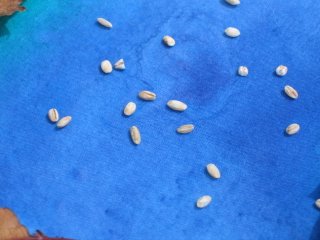
Really, I thought I was done for awhile, meant to put everything back on my cart and roll it out of the extra bathroom for awhile. Maybe if I hadn't read on Marion's blog that she likes to use up what paints she's mixed even if she's supposedly done painting for the day, I wouldn't have given in to my own tendency to want to do the same. Just a little of that teal, a bit more of the blue and quite a bit of the brown begged to be used up, and how could I resist on such a warm, dry and windless day?
This time I covered my board with freezer paper to ensure a smooth surface. I had a plan - to lay the paint on thickly in bands, arrange a variety of my dried leaves on top and sprinkle the remaining surface with table salt and barley. Out in the sun it went. I could already see some interesting blending and diffusion going on. (Clicking on any picture will give you a larger version.)



While I was waiting for it to dry, I decided I could clean up my brushes - the chip brush that spread the teal, the mop brush that spread the blue, and a foam roller brush that spread the brown. I've had that roller for awhile but was hesitant to use it, but no better time than now to see how it worked. My, I really liked it too! Anyway, I'd brought a small piece of white muslin down just in case I was inspired to do something else, so decided to see how much paint was still on that chip brush. Not much but it did leave some fine streaks on the cloth. I figured there probably was quite a bit of the brown in that roller foam, so rolled that next. The paint had collected in the end so I pushed really hard while rolling to get it out. More nice streaks. This could easily be a landscape background - more sandy beaches perhaps.

I wiped the remainder of anything on the brushes on my wipe cloth and dipped it in the rinse water and thought I was done. But no - not all of the blue had come out of its bottle, and I had a couple of squares of hand-dyed fabric on the cart plus some tips for that bottle...Oh why not? So I scribbled and drew wavy intersecting lines just for fun. As you can see, it took me a bit to figure out to keep moving or else I'd get a blot of paint. I can see that a thicker paint would be better for this technique.

This time I really did quit, and went to retrieve my sunprint. Oh, this turned out much better - except that the large leaf in the middle didn't print sharply. Many spots on this are nice, if I look closely I can see the effect of the salt in places and I like the shapes left by the barley. Two successful, fun sessions in a row? Can it be???



This time I covered my board with freezer paper to ensure a smooth surface. I had a plan - to lay the paint on thickly in bands, arrange a variety of my dried leaves on top and sprinkle the remaining surface with table salt and barley. Out in the sun it went. I could already see some interesting blending and diffusion going on. (Clicking on any picture will give you a larger version.)



While I was waiting for it to dry, I decided I could clean up my brushes - the chip brush that spread the teal, the mop brush that spread the blue, and a foam roller brush that spread the brown. I've had that roller for awhile but was hesitant to use it, but no better time than now to see how it worked. My, I really liked it too! Anyway, I'd brought a small piece of white muslin down just in case I was inspired to do something else, so decided to see how much paint was still on that chip brush. Not much but it did leave some fine streaks on the cloth. I figured there probably was quite a bit of the brown in that roller foam, so rolled that next. The paint had collected in the end so I pushed really hard while rolling to get it out. More nice streaks. This could easily be a landscape background - more sandy beaches perhaps.

I wiped the remainder of anything on the brushes on my wipe cloth and dipped it in the rinse water and thought I was done. But no - not all of the blue had come out of its bottle, and I had a couple of squares of hand-dyed fabric on the cart plus some tips for that bottle...Oh why not? So I scribbled and drew wavy intersecting lines just for fun. As you can see, it took me a bit to figure out to keep moving or else I'd get a blot of paint. I can see that a thicker paint would be better for this technique.

This time I really did quit, and went to retrieve my sunprint. Oh, this turned out much better - except that the large leaf in the middle didn't print sharply. Many spots on this are nice, if I look closely I can see the effect of the salt in places and I like the shapes left by the barley. Two successful, fun sessions in a row? Can it be???













































